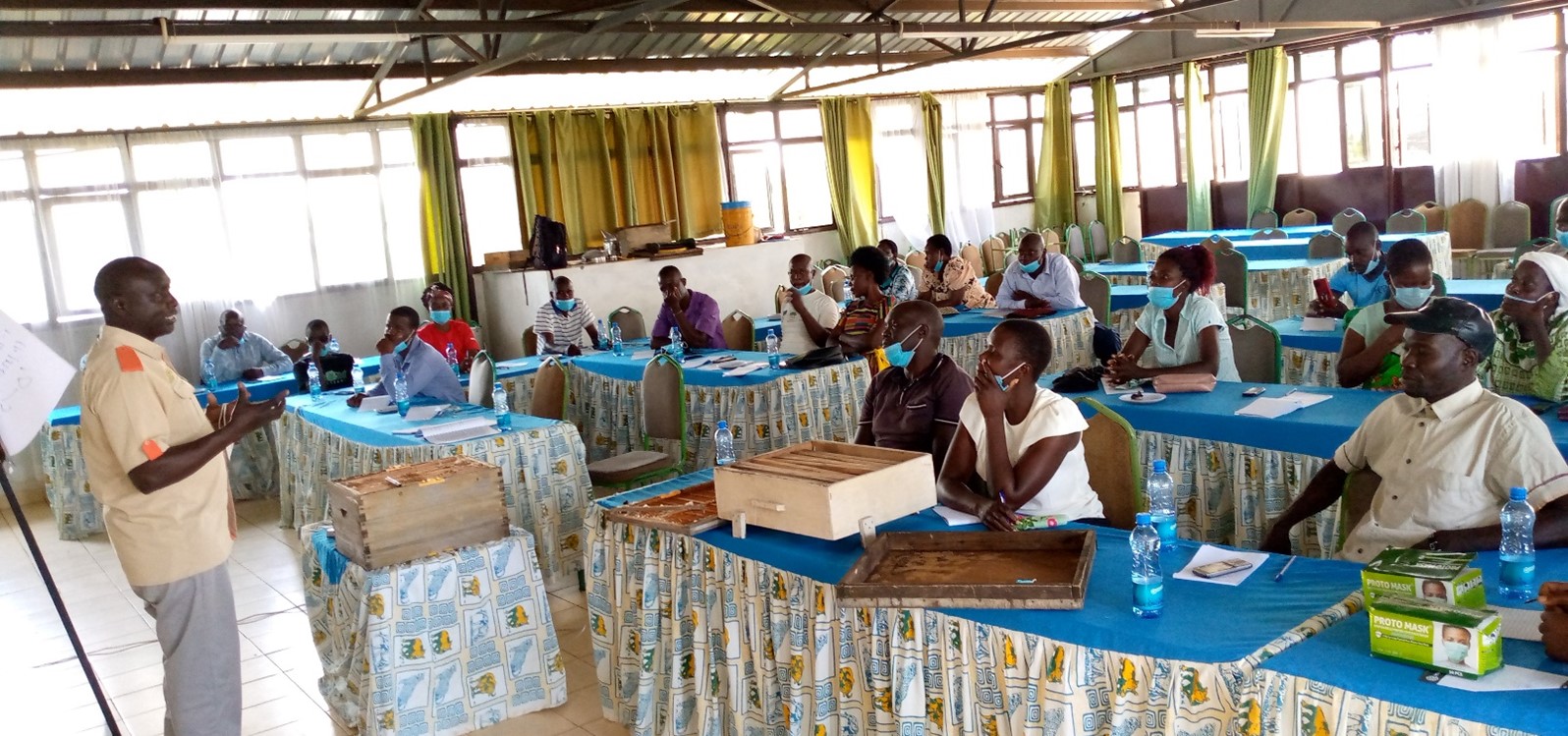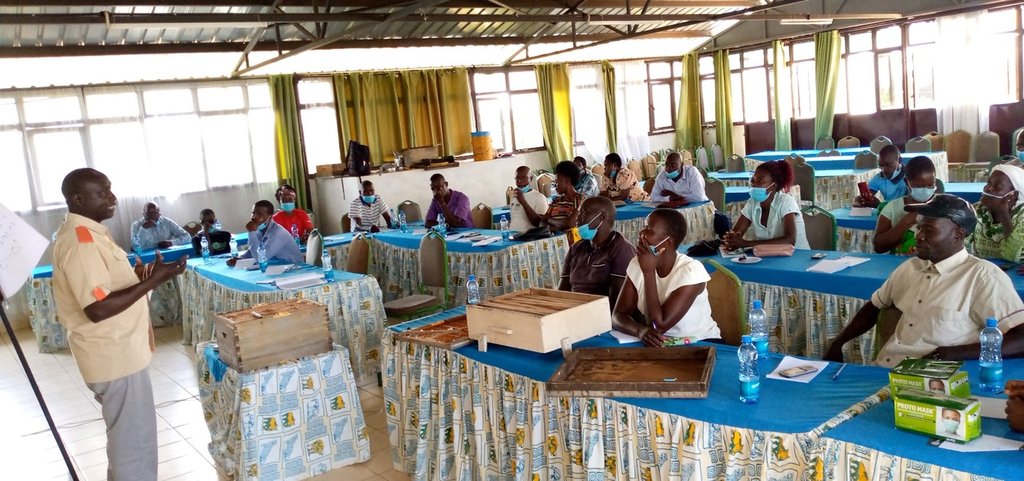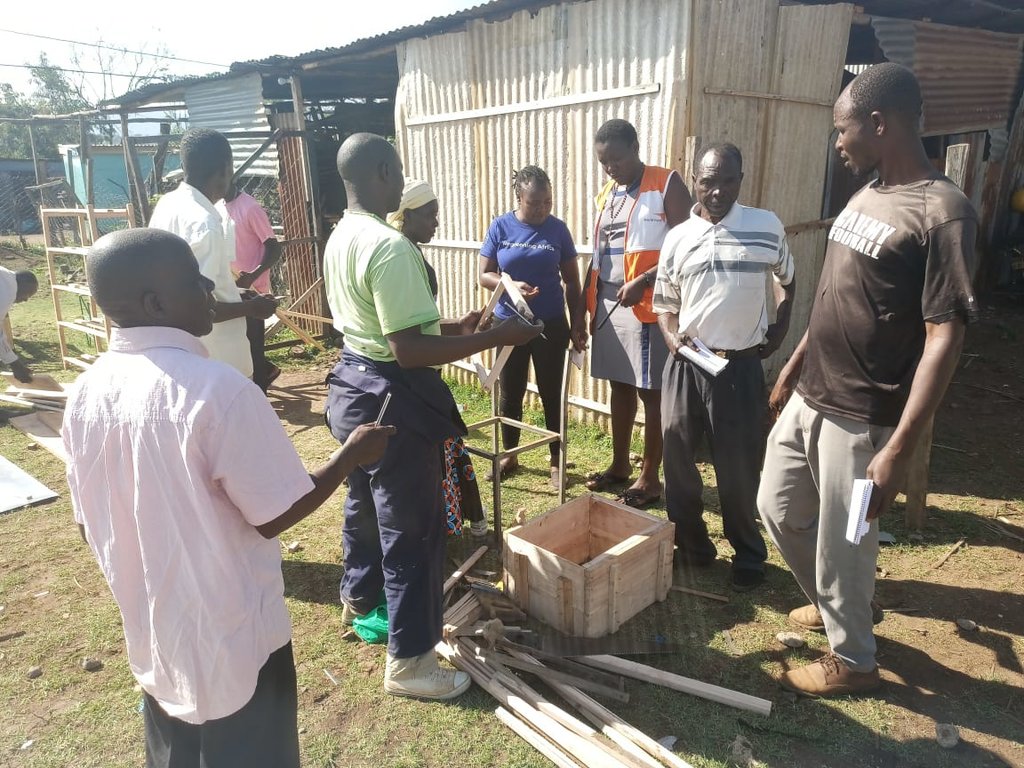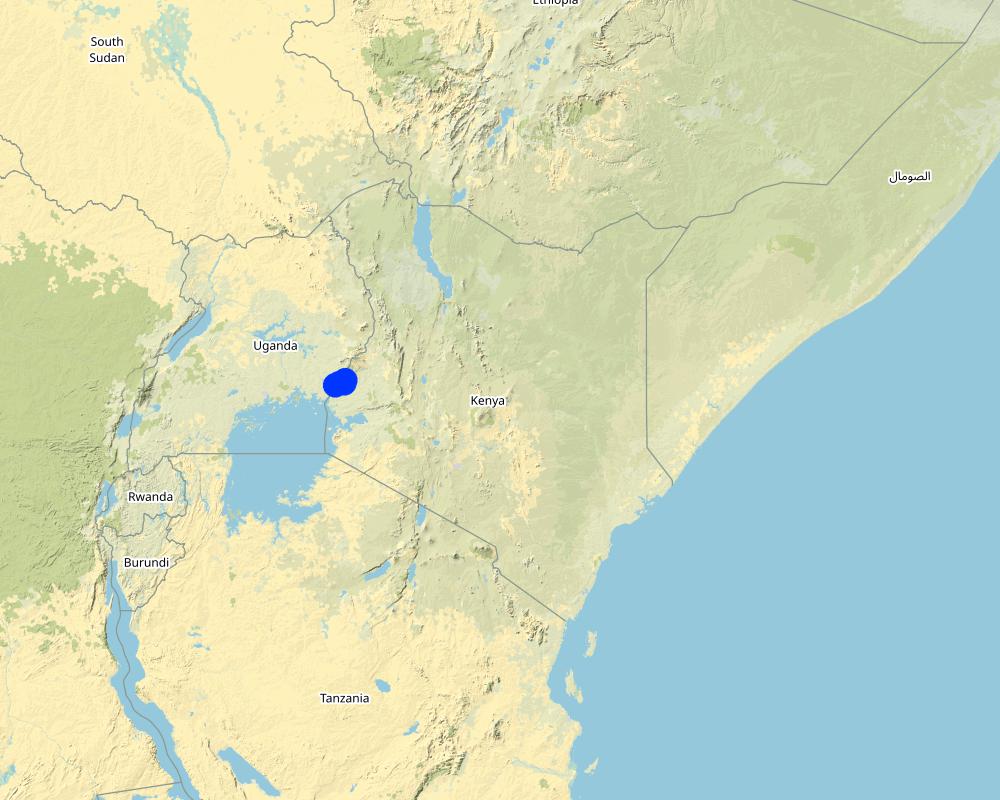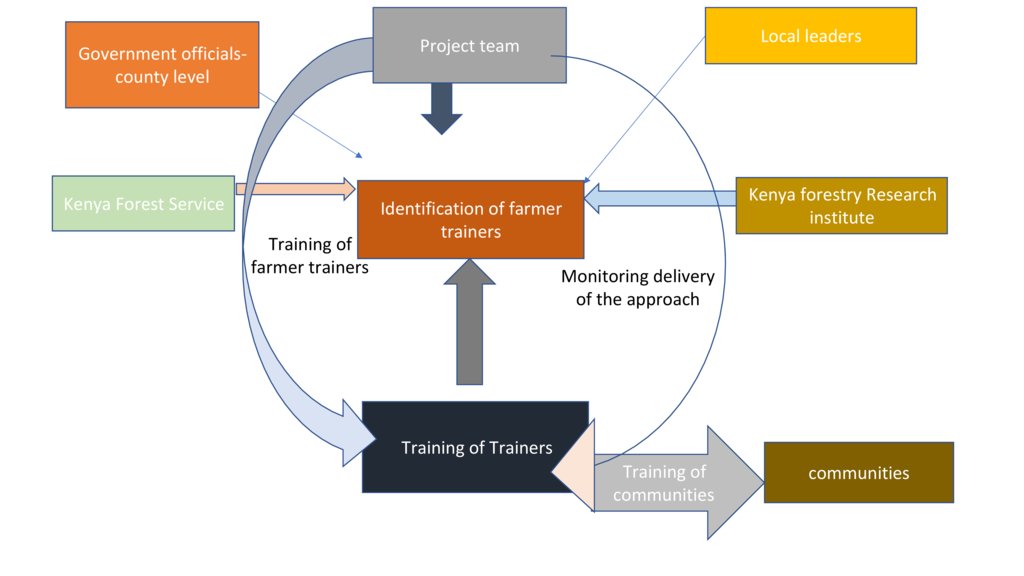Training of Trainers for land restoration through beekeeping [Kenya]
- Creation:
- Update:
- Compiler: Grace Koech
- Editor: –
- Reviewers: William Critchley, Rima Mekdaschi Studer
Training of Trainers (ToTs)
approaches_6624 - Kenya
View sections
Expand all Collapse all1. General information
1.2 Contact details of resource persons and institutions involved in the assessment and documentation of the Approach
Key resource person(s)
co-compiler:
Wambua Brian
+25474608042 / +254707340669
brian_wambua@wvi.org
World Vision Kenya
brian_wambua@wvi.org
Kenya
Name of project which facilitated the documentation/ evaluation of the Approach (if relevant)
Reversing land degradation in Africa by scaling-up Evergreen Agriculture (Regreening Africa)Name of the institution(s) which facilitated the documentation/ evaluation of the Approach (if relevant)
International Centre for Research in Agroforestry (ICRAF) - Kenya1.3 Conditions regarding the use of data documented through WOCAT
When were the data compiled (in the field)?
13/12/2022
The compiler and key resource person(s) accept the conditions regarding the use of data documented through WOCAT:
Yes
2. Description of the SLM Approach
2.1 Short description of the Approach
The Regreening Africa project identifies key individuals within the community who are then trained on land restoration through beekeeping. Through this "training of trainers" approach the trainees then train others.
2.2 Detailed description of the Approach
Detailed description of the Approach:
The Regreening Africa project identifies key individuals within communities who are trained on land restoration through beekeeping: the trainees then train others themselves. The characteristics of this “training of trainers” (ToT) approach is that it is community-based, and those selected for training work within areas they can reach with ease from their homes. They are also required to be practicing, or demonstrating interest in, one or more approaches promoted by the project. The selected persons include women, the disabled, and youth, as well as mature people who have the experience to integrate local knowledge.
The objectives of the approach are to cut down on the cost of implementing land restoration by building capacity at the local level. By promoting peer-learning and establishing learning sites within the community, it is believed that a greater number of people can be efficiently reached. The goal is to achieve more trees on farms (especially "bee-friendly" trees) and increased sales of honey and other products, leading to better living standards and a sustained, healthy environment.
Training includes technologies that cover tree growing (including farmer managed natural regeneration) with an emphasis on beekeeping as a commercial venture within a promising value chain. Thus, they are trained specifically on beekeeping as well as hive making to meet the high demand for honey. They are supported with high value seed and tree seedlings for integration into farms to support their apiary businesses. The main stakeholders involved include World Vision Kenya who mobilize farmers and link them to other actors in beekeeping value chains; ICRAF who provide training on beekeeping and hive making, as well as technologies for tree growing and management; and county government who have constituted a forum to regulate prices. Communities then implement the technologies. Initially the farming communities disliked bees due to possible attacks, but after training about setting up apiaries and bee-based businesses, and based on their experience after implementing the lessons learnt from the training, they have become more receptive to the approach.
2.3 Photos of the Approach
2.4 Videos of the Approach
Comments, short description:
we did not take any videos for this technology
2.5 Country/ region/ locations where the Approach has been applied
Country:
Kenya
Region/ State/ Province:
Homabay
Map
×2.6 Dates of initiation and termination of the Approach
Indicate year of initiation:
2020
If precise year is not known, indicate approximate date when the Approach was initiated:
less than 10 years ago (recently)
Comments:
The technology was going on in some part of the project sites, however the communities lacked the skills on bee colony management, ensuring sufficient bee forage and importance of environmental health for increased production of hive products.
2.7 Type of Approach
- project/ programme based
2.8 Main aims/ objectives of the Approach
To enable communities benefit from the land restoration approaches, equally reach many people with the technology and build local resources and capacities.
2.9 Conditions enabling or hindering implementation of the Technology/ Technologies applied under the Approach
social/ cultural/ religious norms and values
- enabling
The approach provides incentive for farmers to learn from other farmers
availability/ access to financial resources and services
- enabling
implementors can access loans from the local self help groups to expand the approaches. further implementors are parts of saving and loaning groups to allow them save and invest in the technology.
institutional setting
- enabling
Homabay county generated a platform that allows actors to discuss matters relating to the value chain such as prices. further, the county link the actors to other initiatives funded by donors.
collaboration/ coordination of actors
- enabling
actor forums are in place and functional
legal framework (land tenure, land and water use rights)
- enabling
local bylaws are used
policies
- enabling
activities are aligned to existing policies
land governance (decision-making, implementation and enforcement)
- enabling
land tenure in the area is individual, household level discussion incorporates contributions from all the members.
knowledge about SLM, access to technical support
- enabling
the actors are empowered through training, further demonstration plots were established and knowledge products produced to support the actors. others ways of building actors capacity is through the stakeholder forum that has diverse expertise.
markets (to purchase inputs, sell products) and prices
- enabling
markets are available, actors are unable to meet the current demand
workload, availability of manpower
- enabling
beekeeping is not labor intensive
3. Participation and roles of stakeholders involved
3.1 Stakeholders involved in the Approach and their roles
- local land users/ local communities
land owners
provide labor, manage the technology, contribute local knowledge
- community-based organizations
community champions, village loaning and saving association
local experts, share lessons on SLM, provide loans and opportunities for saving
- SLM specialists/ agricultural advisers
County extension agents
provide training and linkages
- researchers
International NGOS, universities, local NGOs
provide technical support, provide research funds
- teachers/ school children/ students
school clubs, patrons, environmental enthusiast
implement technologies, scale the knowledge through skits, songs and poems
- private sector
private nurseries
provide seedlings
- local government
county government constituted a forum to regulate prices
If several stakeholders were involved, indicate lead agency:
ICRAF
3.2 Involvement of local land users/ local communities in the different phases of the Approach
| Involvement of local land users/ local communities | Specify who was involved and describe activities | |
|---|---|---|
| initiation/ motivation | interactive | local community consultation was conducted to determine the land restoration issues. community opinion leaders, community representatives and local leaders are involved. |
| planning | interactive | planning is facilitated by the implementing NGO, communities generate the plans |
| implementation | interactive | community are enabled to implement through trainings and provision of some material as they also contribute part of the materials. |
| monitoring/ evaluation | external support | internal monitoring systems are in place to enable communities adapt to changes to implementation. External reviewers are involved to assess impacts of the intervention. |
3.3 Flow chart (if available)
Description:
government, project team, community leaders identify project stakeholders to be trained, trained farmers train other farmers.
Author:
Grace Koech
3.4 Decision-making on the selection of SLM Technology/ Technologies
Specify who decided on the selection of the Technology/ Technologies to be implemented:
- all relevant actors, as part of a participatory approach
Explain:
participatory approaches are adopted for ownership and adoption, communities understand their landscape and own indigenous knowledge and history of what works and what does not. expert bring additional knowledge to improve the local practices, counties provide linkage for external support to strengthen the approach further.
Specify on what basis decisions were made:
- evaluation of well-documented SLM knowledge (evidence-based decision-making)
4. Technical support, capacity building, and knowledge management
4.1 Capacity building/ training
Was training provided to land users/ other stakeholders?
Yes
Specify who was trained:
- land users
- field staff/ advisers
If relevant, specify gender, age, status, ethnicity, etc.
Males, females and youth are involved in the training, ensuring women form 30% of the trainees and trainees ages ranged between 8-60 years. Usually training is conducted at local level and most of the communities are of the same ethnic group.
Form of training:
- on-the-job
- farmer-to-farmer
- demonstration areas
- public meetings
Subjects covered:
Beekeeping for land restoration, tree nursery establishment and management, honey value chain development
Comments:
The approach is specific to beekeeping for land restoration
4.2 Advisory service
Do land users have access to an advisory service?
Yes
Specify whether advisory service is provided:
- on land users' fields
Describe/ comments:
farmers convene at a common place to learn about a specific technology.
4.3 Institution strengthening (organizational development)
Have institutions been established or strengthened through the Approach?
- yes, a little
Specify the level(s) at which institutions have been strengthened or established:
- local
Describe institution, roles and responsibilities, members, etc.
local farmer groups have been registered to enable them receive recognition and financial support from micro credit institutions
Specify type of support:
- financial
- capacity building/ training
- equipment
Give further details:
farmer groups develop proposals that they present to financial institutions or other NGOs to allow them access fund, some institutions provide equipment
4.4 Monitoring and evaluation
Is monitoring and evaluation part of the Approach?
Yes
Comments:
approach is reviewed periodically to allow actors adapt to prevailing situations.
If yes, is this documentation intended to be used for monitoring and evaluation?
Yes
Comments:
The information help the planners to decide on better ways to improve the technology
4.5 Research
Was research part of the Approach?
No
5. Financing and external material support
5.1 Annual budget for the SLM component of the Approach
If precise annual budget is not known, indicate range:
- 2,000-10,000
Comments (e.g. main sources of funding/ major donors):
EU
5.2 Financial/ material support provided to land users
Did land users receive financial/ material support for implementing the Technology/ Technologies?
Yes
If yes, specify type(s) of support, conditions, and provider(s):
The training of trainers were facilitated using the project funds to attend trainings.
5.3 Subsidies for specific inputs (including labour)
- agricultural
| Specify which inputs were subsidised | To which extent | Specify subsidies |
|---|---|---|
| seeds | partly financed | Training of trainers received training on nursery establishment and were supported with seeds of preferred species. |
If labour by land users was a substantial input, was it:
- voluntary
5.4 Credit
Was credit provided under the Approach for SLM activities?
Yes
Specify conditions (interest rate, payback, etc.):
The training of trainers accessed credit through the self-help groups. The interest rates varies from 1-10% depending on the saving groups. most of the training of trainers saved in more than more saving and loaning group.
Specify credit providers:
self help groups
Specify credit receivers:
Training of Trainers and local communties
5.5 Other incentives or instruments
Were other incentives or instruments used to promote implementation of SLM Technologies?
Yes
If yes, specify:
Recognition, best performing training of trainers were visited by the donors and other partners to learn from the approach. that gave them a sense of prestige and motivation and challenged the other ToTs to do better so next time they receive visitors.
6. Impact analysis and concluding statements
6.1 Impacts of the Approach
Did the Approach empower local land users, improve stakeholder participation?
- No
- Yes, little
- Yes, moderately
- Yes, greatly
beekeeping for land restoration is widely adopted in Homabay county.
Did the Approach enable evidence-based decision-making?
- No
- Yes, little
- Yes, moderately
- Yes, greatly
incentives for land restoration was a major learning from the approach
Did the Approach help land users to implement and maintain SLM Technologies?
- No
- Yes, little
- Yes, moderately
- Yes, greatly
yes, beekeeping generate food and income for the households that encouraged them to scale and maintain the integrity of the environment.
Did the Approach improve coordination and cost-effective implementation of SLM?
- No
- Yes, little
- Yes, moderately
- Yes, greatly
the cost incurred was training, which was also done at the local level
Did the Approach mobilize/ improve access to financial resources for SLM implementation?
- No
- Yes, little
- Yes, moderately
- Yes, greatly
some groups were able to get loans from the loaning and saving groups
Did the Approach improve knowledge and capacities of land users to implement SLM?
- No
- Yes, little
- Yes, moderately
- Yes, greatly
yes through peer learning, knowledge products, experience from implementation
Did the Approach improve knowledge and capacities of other stakeholders?
- No
- Yes, little
- Yes, moderately
- Yes, greatly
presentation of the approaches and interactive sessions during joint learning and reflection meetings
Did the Approach build/ strengthen institutions, collaboration between stakeholders?
- No
- Yes, little
- Yes, moderately
- Yes, greatly
through the value chain platforms the stakeholders were able to identify others opportunities for linkages and partnership.
Did the Approach mitigate conflicts?
- No
- Yes, little
- Yes, moderately
- Yes, greatly
Did the Approach empower socially and economically disadvantaged groups?
- No
- Yes, little
- Yes, moderately
- Yes, greatly
the approach is inclusive
the approach is inclusive
the approach is inclusive
Did the Approach improve issues of land tenure/ user rights that hindered implementation of SLM Technologies?
- No
- Yes, little
- Yes, moderately
- Yes, greatly
youths and women were allowed to practise SLM on family land
Did the Approach lead to improved food security/ improved nutrition?
- No
- Yes, little
- Yes, moderately
- Yes, greatly
bees provide honey that is used as food. trees foraged on by trees also provided other products such as fruits and product sold to generate income.
Did the Approach improve access to markets?
- No
- Yes, little
- Yes, moderately
- Yes, greatly
through linkages and sharing of market information
Did the Approach lead to improved access to water and sanitation?
- No
- Yes, little
- Yes, moderately
- Yes, greatly
Did the Approach lead to more sustainable use/ sources of energy?
- No
- Yes, little
- Yes, moderately
- Yes, greatly
through trainings on FMNR farmers are able to access pruning for use as firewood and reducing destruction of the entire tree
Did the Approach improve the capacity of the land users to adapt to climate changes/ extremes and mitigate climate related disasters?
- No
- Yes, little
- Yes, moderately
- Yes, greatly
crop failure due to unreliable rains are mitigated through use of tree crops established on farms and reduced surface runoff improving rainfall productivity.
Did the Approach lead to employment, income opportunities?
- No
- Yes, little
- Yes, moderately
- Yes, greatly
for nursery operators, fruit sellers, honey producers and processors
6.2 Main motivation of land users to implement SLM
- increased production
by increasing diversity and number of trees onfarms bees access more forage and higher production
- increased profit(ability), improved cost-benefit-ratio
using inbuilt skills to make hives, reduces the cost of buying hives and hence the cost of production greatly reduced.
- reduced land degradation
understanding the relationship between environment integrity and honey productivity enabled communities aspire to restore more land for better quality and quantity of honey produced.
- reduced risk of disasters
food insecurity risk reduced due to access of honey
- affiliation to movement/ project/ group/ networks
importance of village loaning and saving groups to facilitate access to finance to support SLM
- environmental consciousness
- enhanced SLM knowledge and skills
understanding the relationship between environment integrity and honey productivity enabled communities aspire to restore more land for better quality and quantity of honey produced.
6.3 Sustainability of Approach activities
Can the land users sustain what has been implemented through the Approach (without external support)?
- yes
If yes, describe how:
sustainability is integral part of the approach, the approach thus build local institutions structures to ensures the technology is implemented with or without the external support
6.4 Strengths/ advantages of the Approach
| Strengths/ advantages/ opportunities in the land user’s view |
|---|
| inclusive |
| participatory |
| stakeholder led |
| Strengths/ advantages/ opportunities in the compiler’s or other key resource person’s view |
|---|
| inclusive |
| stakeholder led |
| participatory |
6.5 Weaknesses/ disadvantages of the Approach and ways of overcoming them
| Weaknesses/ disadvantages/ risks in the land user’s view | How can they be overcome? |
|---|---|
| need strong leadership to succeed | leaders that are visionary should be appointed |
| Weaknesses/ disadvantages/ risks in the compiler’s or other key resource person’s view | How can they be overcome? |
|---|---|
| change of role/ change of government incase of county officials | ensure proper hand over and induction for continuity |
7. References and links
7.1 Methods/ sources of information
- compilation from reports and other existing documentation
7.2 References to available publications
Title, author, year, ISBN:
Regreening Africa annual reports
Available from where? Costs?
open access
7.3 Links to relevant information which is available online
Title/ description:
Regreening Africa project
URL:
https://regreeningafrica.org/
Links and modules
Expand all Collapse allLinks
No links
Modules
No modules


